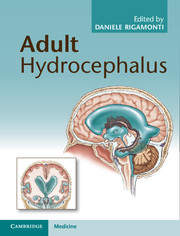Book contents
- Adult Hydrocephalus
- Adult Hydrocephalus
- Copyright page
- Dedication
- Dedication
- Contents
- Contributors
- Prologue
- Section 1 Basic sciences
- Section 2 Pathophysiology
- Section 3 Diagnosis
- Section 4 Treatment and outcomes
- 16 Hydrocephalus shunt procedures
- 17 Hydrocephalus shunts
- 18 Management of shunts in normal pressure hydrocephalus
- 19 Endoscopic third ventriculostomy
- 20 Outcome of idiopathic normal pressure hydrocephalus
- Section 5 Associated conditions
- Epilogue
- Index
17 - Hydrocephalus shunts
Principles, hardware, shunt testing
from Section 4 - Treatment and outcomes
Published online by Cambridge University Press: 05 February 2014
- Adult Hydrocephalus
- Adult Hydrocephalus
- Copyright page
- Dedication
- Dedication
- Contents
- Contributors
- Prologue
- Section 1 Basic sciences
- Section 2 Pathophysiology
- Section 3 Diagnosis
- Section 4 Treatment and outcomes
- 16 Hydrocephalus shunt procedures
- 17 Hydrocephalus shunts
- 18 Management of shunts in normal pressure hydrocephalus
- 19 Endoscopic third ventriculostomy
- 20 Outcome of idiopathic normal pressure hydrocephalus
- Section 5 Associated conditions
- Epilogue
- Index
Summary
Keywords
- Type
- Chapter
- Information
- Adult Hydrocephalus , pp. 190 - 206Publisher: Cambridge University PressPrint publication year: 2014
- 2
- Cited by



